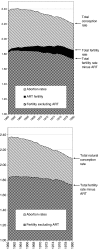Declining trends in conception rates in recent birth cohorts of native Danish women: a possible role of deteriorating male reproductive health
- PMID: 17976178
- PMCID: PMC2440321
- DOI: 10.1111/j.1365-2605.2007.00827.x
Declining trends in conception rates in recent birth cohorts of native Danish women: a possible role of deteriorating male reproductive health
Abstract
Recent findings of poor semen quality among at least 20% of normal young men in Denmark prompted us to use unique Danish registers on births and induced abortions to evaluate a possible effect of the poor male fecundity on pregnancy rates among their presumed partners--the younger cohorts of women. We have analysed data from the Danish birth and abortion registries as well as the Danish registry for assisted reproduction (ART) and defined a total natural conception rate (TNCR), which is equal to fertility rate plus induced abortion rate minus ART conception rate. A unique personal identification number allowed the linkage of these databases. Our database included 706,270 native Danish women born between 1960 and 1980. We used projections to estimate the fertility of the later cohorts of women who had not yet finished their reproduction. We found that younger cohorts had progressively lower TNCR and that in terms of their total fertility rate, the declining TNCR is compensated by an increasing use of ART. Our hypothesis of an ongoing birth cohort-related decline in fecundity was also supported by our finding of increasing and substantial use of ART in the management of infertility of relatively young couples in the later cohorts. Furthermore, the lower rates of induced abortion among the younger birth cohorts, often viewed as a success of health education programs, may not be fully explained by improved use of contraception. It seems more likely that decreased fecundity because of widespread poor semen quality among younger cohorts of otherwise normal men may explain some of the observed decline in conception rates. This may imply increasing reproductive health problems and lower fertility in the future, which is difficult to reverse in the short term. The current and projected widespread use of ART in Denmark may be a sign of such an emerging public health problem.
Figures





References
-
- Andersen A N, Erb K. Register data on assisted reproductive technology (ART) in Europe including a detailed description of ART in Denmark. International Journal of Andrology. 2006;29:12–16. - PubMed
-
- Andersen A G, Jensen T K, Carlsen E, Jorgensen N, Andersson A M, Krarup T, Keiding N, Skakkebaek N E. High frequency of sub-optimal semen quality in an unselected population of young men. Human Reproduction. 2000;15:366–372. - PubMed
-
- Andrade A J, Grande S W, Talsness C E, Gericke C, Grote K, Golombiewski A, Sterner-Kock A, Chahoud I. A dose response study following in utero and lactational exposure to di-(2-ethylhexyl) phthalate (DEHP): reproductive effects on adult male offspring rats. Toxicology. 2006;228:85–97. - PubMed
-
- Baird D D, Wilcox A J, Weinberg C R. Use of time to pregnancy to study environmental exposures. American Journal of Epidemiology. 1986;124:470–480. - PubMed
-
- Baird D T, Collins J, Egozcue J, Evers L H, Gianaroli L, Leridon H, et al. Fertility and ageing. Human Reproduction Update. 2005;11:261–276. - PubMed
Publication types
MeSH terms
LinkOut - more resources
Full Text Sources
Medical

